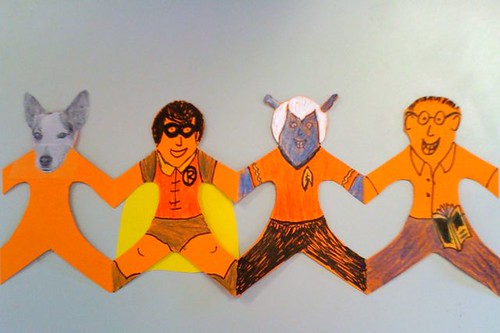A primary teacher-librarian asked about how T-L colleagues felt about taking groups of students “to get NAPLAN results up”!
I have no problem with the concept. Working with a group of students on the language used in mathematics, or deconstructing written problems using steps in the information process as a strategy for understanding, or, especially, concentrating on the literacy skills used in reciprocal numeracy, are very much in the domain of a teacher-librarian.
I urged my colleague to take the challenge, but insist on a focus that is drawn from the online NAPLAN support materials. Lots of information-oriented perspectives here!
This term, I’m about to work with several groups of Stage 1 students using mathematical language and nursery rhyme characters, to create wiki pages of short jointly-constructed narratives. Maths literacy is our current PSP focus and I’m happy to share my T-L expertise in this area with teaching colleagues, even though I’ve never considered maths teaching to be a particular personal passion. More on this as the project firms up.
During my time as editor of “Scan” professional journal (1998-2002), I commissioned several articles from both NSW DET curriculum advisors and teacher-librarians on the topic of mathematics and the school library. We had an excellent one from Peter Gould in 2002 on “numeracy” as the “sibling of literacy”. Definitely worth checking out those back issues; some aspects have probably dated a little, but the following list of back-issue abstracts shows that there are many opportunities for TLs to assist with the crucial KLA of mathematics.
GOULD, Peter. ‘More than words’ in “Scan” 21(1) February, 2002, pp 8-12.
“Numeracy involves using mathematics effectively to make sense of the world. It is a fundamental component of learning, performance, discourse, and critique. The State Literacy and Numeracy Plan identifies a range of key objectives in the Department’s support for numeracy.”
TODD, Ross J. & O’CONNELL, Judith. ‘Teachers as learners: transformational leadership and autonomous learning in an electronic age’ in “Scan” 18(3) August, 1999, pp 41-47.
“A professional development program for secondary teachers was constructed… [including…] exploring cross faculty mathematics integration…”
HARDAGE, Paul. ‘The language of other subjects’ in “Scan” 18(1) February, 1999, pp 10-13.
“The social view of language has led to a paradigm shift about language; ‘the language of different subject disciplines’ replaces ‘literacy across the curriculum’. Today’s teachers and teacher-librarians use the explicit instructional practices associated with text types, and emphasise social purpose.”
MAHER, Cynthia, GRAHAM, Peter & LANNEN, Brian. ‘Mathematics + collaboration + technology = success’ in Scan 18(1) February, 1999, pp 20-23.
“Gifted and talented mathematics students from small, isolated schools were involved in the MEGA (Mathematics Enrichment Group Albury) Project. Through email and the Internet, teachers provided activities to a virtual class, culminating in a Maths Activity Day hosted by Holbrook Public School.”
COOK, Jan. ‘Maths on the Net’ in “Scan” 18(1) February, 1999, p 24.
“In the Broken Hill District, a program was initiated which integrates mathematics, problem solving and ICT. Email and the Internet provide communication between virtual teams of students and schools, enhancing: literacy skills in mathematics; cooperation; and training and development of teachers.”
GOULD, Peter. ‘Mathematics K-6: the outcomes addendum’ in “Scan” 17(3) August, 1998, p 4.
“The new ‘Outcomes and indicators addendum for Mathematics K-6′ impacts on schools’ scope and sequence charts and whole-school planning. The article advocates collaborative programming, knowledge of students’ prior achievements and support from the teacher-librarian. A matrix suggests key programming questions.”

